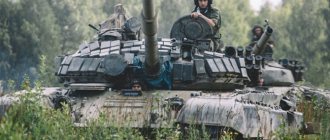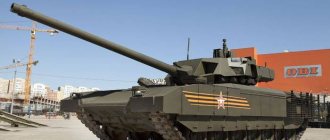Finally, the Ministry of Defense presented photographs of the latest Russian tanks and combat vehicles on its official website. Now we can see what armored vehicles look like on the Armata, Kurganets, Boomerang platforms and the Coalition self-propelled artillery mount, as well as the Kornet anti-tank missile corps.
Since 2000, the development of the tank on the Armata platform has been carried out by Uralvagonzavod in Nizhny Tagil. In 2013, “Armata” was first presented at a closed show, and mass production of the latest vehicles based on it and their delivery to the troops began after testing in 2020.
Russian tank building is in constant development. The new types of combat vehicles are based on the latest achievements of science and technology. In terms of their tactical and technical characteristics, the latest Russian tanks are significantly superior to vehicles of previous generations.
Developments in recent years have been aimed at creating a heavy unified platform under the code “Armata”. This is a promising tracked platform, on the basis of which fifth-generation battle tanks will be created for the Russian Armed Forces. It is planned to produce a number of different types of military equipment on their chassis.
The layout of the "Almata" is almost identical to the unfinished project of the T-95 or "Black Eagle" tank. Inside the hull there is a habitable armored capsule in which the crew is placed. Behind it is the fighting compartment, which includes an uninhabited turret on top, and the engine compartment is located behind it.
The T-14 “Armata” will replace the T-72, T-80, and T-90 tanks currently in service.
Tactical and technical data
- Total weight – 48 t
- Crew – 3 people
- Engine power – 1500-2000 hp.
- There is an additional power unit
- Time required to replace the engine – 0.5 hours
- Maximum speed – 90 km/h
- Power reserve – 500 km
- Target detection range – 5 km
- Target engagement range – 8 km
- Combat rate of fire – 12 rounds per minute
There is the possibility of all-round visibility using a special camera, a commander’s panoramic sight is also installed, and there is active and dynamic protection. The new radar station is capable of simultaneously tracking 25 aerodynamic and 40 dynamic targets and monitoring an area with a radius of more than 100 kilometers. The T-14 is capable of automatically destroying all missiles or shells of any type flying at it.
For the first time in Russia, a tank will be equipped with a digital information and control system - a “digital board”. It launches, controls, diagnoses and adjusts the parameters of mechanisms. If a problem is detected, the electronics reports what exactly has gone wrong and suggests a solution to the problem and the necessary measures. In other words, the breakdown will be repaired not by a repair team or crew, but by electronics.
T-54/55
The T-54 family of tanks were developed after World War II to eliminate the shortcomings inherent in the later T-34s. Namely, a modernized, but still not powerful enough 85 mm cannon and thin armor. Visually, the T-54 and T-55 are very similar.
In keeping with typical Soviet design, the T-54/55 was mechanically uncomplicated and relatively easy to operate. A very compact design with a good power-to-weight ratio and wide tracks made it very mobile. But the squat silhouette of the tank caused limitations in comfort for Soviet crews. On the T-54/55 platform there was a 100-mm rifled gun, which was modern at the time of its appearance, but by today's standards is considered insufficiently powerful.
Tanks of the T-54/55 family were widely exported to the Warsaw Pact countries, the Middle East, throughout Asia and many African countries. Their relative simplicity allowed them to be gradually upgraded with additional armor, more powerful main guns and upgraded engines. This significantly increased their service life. Tanks of the T-54/55 family have taken part in many modern conflicts and wars. Including in Syria, Libya, Yemen and Iraq. This makes them perhaps one of the most battle-hardened tanks around.
Armament
The main caliber of the Armata is the 2A82 125 mm smoothbore gun. It is controlled completely remotely. It is also possible to install a 2A83 152 mm gun. A fundamentally new automatic ammunition feeder is used, the capacity of which reaches 40 projectiles for various purposes. Shooting can be carried out effectively both from a stationary position and on the move. The tank's ammunition is located in a special protected module.
"Armata" fires high-explosive fragmentation, armor-piercing and cumulative projectiles, as well as electronic, satellite and infrared guided missiles. In fact, the T-14 is not just a tank, but a universal attack vehicle. It combines a tactical missile system, an anti-aircraft anti-aircraft system, a reconnaissance complex and the tank itself.
The weapon system of the vehicle includes a 7.62 mm machine gun coaxial with the cannon. It is located on the outside of the tower, connected to the gun by a drive. The loaded ammunition of the machine gun contains 1000 rounds of ammunition, the same amount is stored in belts at the rear of the turret in a box for spare parts. Additionally, a 12.7 mm Kord machine gun can be installed with a loaded ammo cartridge for 300 rounds and the same amount in a spare parts box. The machine gun is controlled remotely using a computer and electric drives.
Since 2014, especially for the new generation tank of the Russian Armed Forces, a new guided missile with improved characteristics has been developed. It is subject to high requirements for armor penetration, target engagement range and armor-damaging power, but while maintaining the 125 mm caliber.
T-90 family
The T-90 is a late Soviet development designed to replace outdated tanks of the T-64, T-72 and T-80 families.
The T-90 is a bit like Frankenstein: it's essentially a heavily modernized T-72 hull with improved armor and a T-80 turret with the same 125mm smoothbore main gun. It is equipped with a dynamic protection system and is not very heavy - only fifty tons. Despite the powerplant's shortcomings, the T-90 and its variants can give the American M1 a run for its money, especially with potentially better armor.
Tank fire control
Firing in the T-14 is controlled by an aiming system. Its main advantages:
- Availability of sighting and built-in laser control channels, range finder
- Possibility of adjusting the sighting channel with a magnification of 4 to 12
- The range at which the object is recognized is 5 km
- The maximum distance measured by the rangefinder is 7.5 km
- Equipment for a backup sight on the dependent sight line
- Ballistic computer device
- Automatic target tracking
- Advanced weapon stabilizer
The tank is equipped with radars based on an AFAR antenna array, consisting of a large number of cellular microwave transmitters. Such an antenna has the ability to quickly change the location direction.
T-95
Photo: wikimedia.org
Possibly the deadliest tank in Russia. But in reality it only exists as one prototype.
Design of the T-95 began in 1988 with the goal of surpassing NATO main battle tanks in both armor and firepower.
The main gun was supposed to be massive - 152 mm. It could fire artillery shells, which expanded the range of ammunition and theoretically provided the ability to fire at targets beyond visual range.
The T-95 turret broke traditional Soviet tank doctrine. She was unusually tall. This made it possible to increase the height and tilt of the gun, which was necessary when firing artillery shells. In addition, the tank was equipped with an active protection system. However, the project did not go into series.
Powerplant, transmission and control
The tank's power plant is based on a domestic diesel engine of the A-85-3A brand. Its resource is no less than 2000 hours. Specifications:
- Engine type – X-shaped, 12-cylinder, four-stroke with gas turbine supercharging and intermediate air cooling
- Mixture formation - fuel injection
- Power – 1500 hp
- Weight – 1550 kg
- Dimensions: length – 813 mm, width – 1300 mm, height – 820 mm
- The Armata's suspension is controlled, 6-roller, with vane shock absorbers. The differential mechanism is equipped with a hydrostatic transmission. The 12-speed automatic transmission can be shifted manually. The controls include: a steering wheel, brake and gas pedals, and a gear shift lever.
What kind of army is this?
Russian tank forces are the main striking force of the ground forces. They are mainly used in conjunction with motorized rifle units in the main directions. This branch of the military is designed to perform the following main tasks:
1. In defense - direct support of motorized rifles when repelling an enemy offensive, launching counterattacks and counterstrikes.
2. On the offensive - delivering powerful strikes that cut the front to great depths, developing success, defeating the enemy in oncoming battles and battles.
Russian tank forces are divided into brigades and battalions; they have great firepower, resistance to the damaging effects of nuclear weapons, and high maneuverability and mobility. They are able to make maximum use of the results of nuclear or fire destruction of the enemy and achieve the final goal of an operation or battle in a short time.
Comprehensive protection system
The protection system of the T-14 tank consists of several components:
- Armor protection. The new tank on the Armata platform is protected by specially developed armor steel. Its characteristics make it possible to reduce the thickness of the sheet and the overall weight of the structures.
- Active protection "Afganit", adopted for implementation in 2014. Specially designed charges are fired against enemy shells and missiles, hitting them at a distance of no more than 20 meters. The launcher is made of a carriage that rotates in horizontal and vertical planes. The impact core is aimed at the target using programmed initiation of fuses.
- Dynamic protection. Its essence lies in the fact that three blocks are installed on the sides of the tower. These are containers with dynamic protection elements that are separated by filler. The sides are protected by installing seven similar blocks. The aft area is covered with lattice screens on the hull and turret. Installed before military operations in special cases, for example, in urban conditions. The additional weight amounts to almost a ton, but this does not significantly reduce the mobility of the tank.
The T-14 is not just a new tank, it determined the prospects for tank building in Russia for decades to come. In the coming years, it is planned to produce at least 2-3 thousand tanks of this type and armored vehicles based on it.
Video: new Russian tanks
T-34
The iconic T-34 debuted in 1940 and was designed to address the shortcomings of the BT (Big Tank) series of tanks, which were light, fast, lightly armed and lightly armored.
Unlike them, the T-34 had more reliable armor. Its front hull was 45-47 mm thick, and its steep angle reduced the effectiveness of German anti-tank guns, especially the German Pak 36, whose 37 mm shells reportedly bounced off the T-34's hull.
Early production models were relatively light - 26 tons - and had wider tracks, which provided them with greater maneuverability - a decisive advantage when negotiating rough terrain in muddy conditions.
The first T-34s were equipped with a 76.2 mm cannon, which was effective against early-war German armor. At the end of the war, the installation of a modernized 85 mm gun was required.
The T-34 also had weak points. Often their cases were made of several types of steel, which was not always hardened properly. This made the armor too fragile. Tank tracks often broke. There were problems with the tower due to poor quality drives.
Russian tank forces: revival after decline?
The crisis that befell the Russian army in the 90s of the last century, of course, did not spare the tank troops. And the concern of ordinary people wondering “how many tanks Russia has” is completely justified. After all, the nineties literally became a black page in the history of our army. Take, for example, the rapid withdrawal of troops from Mongolia and Eastern Europe, when a lot of ultra-modern equipment at that time was left in adjacent territories, and that which was returned was, in fact, thrown into the mud, with consequences for the equipment. As a result, expensive cars were reduced to scrap metal. In addition, personnel suffered significant damage: a huge number of very promising officers with impressive combat experience were forced to leave the ranks of the armed forces.
The first “bell” for the country’s leadership was the conflict in Chechnya, when hastily assembled units, often with faulty and dismantled equipment, began to suffer serious losses. However, this tragedy did not stop the further degradation of Russian tank forces. The quality of personnel training left much to be desired, and the acquisition of new generation equipment was completely stopped. The development of new models was based on the enthusiasm of designers and engineers, as well as individual military leaders. The defense complex producing armored vehicles either became bankrupt or reoriented towards export.
Combat capabilities
Russian tank divisions, their formations and subunits allow them to conduct active combat operations both day and night, in a significant separation from the main forces, conduct raids behind enemy lines, destroy enemy equipment and manpower in oncoming battles and battles, and overcome radioactive zones on the move. infection, as well as crossing water bodies. In addition, they are capable of quickly creating a very strong defense, as well as successfully resisting attacks by significantly superior enemy forces.
The development of the combat capabilities of this type of troops is carried out by equipping it with more advanced types of armored vehicles, which optimally combine the following most important combat qualities: high firepower, reliable protection and maneuverability. Combined-arms tank units play an important role in improving the necessary organizational forms. This primarily corresponds to the content of the tactics of conducting modern combat operations.
Would-be reformers
The rearmament program adopted by the Ministry of Defense specified in detail how many armored vehicles needed to be modernized and how many new tanks should be manufactured. True, it was still not clear which models should be produced: T-90A or T-95? As a result, the battered T-72B, which had survived two Chechen wars, as well as the T-62, nicknamed “museum”, were sent to resolve the Georgian conflict. The tank forces showed their best performance in this operation, as a result of which the southern group received the main Russian tank, the T-90A, into service. Probably in order to cool down the militant Saakashvili.
After the events described above, another army reform begins in the country. As a result, Russian tank forces were reduced to the level of battalions and a few brigades. The unfortunate reformers refused to purchase the T-90A, and the development of the new Burlak combat module was completely stopped. And, most importantly, Russia’s promising most modern tank, the T-95, never left the assembly line and was sent to scrap. However, the country's leadership came to their senses in time, the Minister of Defense was removed from his post and a new one was appointed. The result of such changes was a new serious project in tank building - the development of a new platform "Armata" based on the T-95 and "Object 640" ("Black Eagle"). "Armata" will be a universal platform for a new generation of armored vehicles: self-propelled guns, tanks, infantry and support vehicles, as well as repair and recovery equipment. This installation has no analogues in the world; all innovative developments of Russian design bureaus are collected here.
Still to come
2013 was a landmark year in the life of the Russian tank forces: as numerous surprise inspections have shown, many reforms did not affect the quality of combat training. Therefore, a strong-willed decision was made to sharply increase the norms of allocated ammunition. In addition, much has been done to increase the prestige of this type of troops. No matter how much they scolded the Tank Biathlon, thanks to these competitions, the citizens of our country for the first time in many years remembered that we, it turns out, still have tank troops. The Kantemirovskaya division was recreated. And currently, active rearmament and modernization of combat vehicles is underway. Already today, even though they are experienced, the first samples of the “Armata” family have already been manufactured.
However, unfortunately, it is too early to talk about results. We can only note the positive dynamics. Answering the reader’s question about what tanks are in Russia’s arsenal today, all that remains is to state the fact that the basis of our armed forces is still the fleet of old T-72B and T-80BV equipment. There is still a lot to be done to make our army truly modern.










